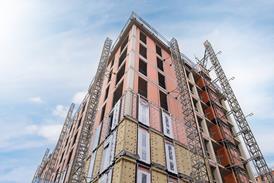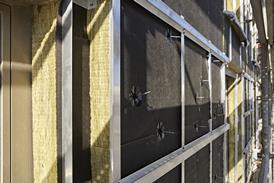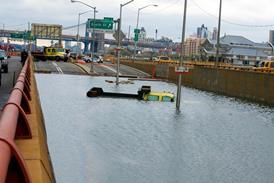Developments to the Building Regulations need to be supported by a RIA. This means carrying out investment appraisal, assessing risks, and putting a value on life and injuries.
The costs and benefits of each option are identified and quantified wherever possible to inform public debate about regulation. Costs to small businesses are highlighted because regulations can often impose greater burdens on smaller firms.
In January 1998 the Government published its Principles of good regulation. This pamphlet stated that regulations should be measured against five principles:
Investment appraisal
Put simply, the concept of present value hinges on the fact that, regardless of inflation, a sum of money received today is worth more than the same sum of money received in, say, a year's time.
The net present value of an investment project is the sum of its discounted future cash flows. When comparing a number of mutually exclusive projects, the one with the highest net present value is usually preferred.
In the context of cost-effectiveness of energy efficiency measures, there is often an initial capital cost followed by a stream of annual fuel (cash) savings. The choice of discount rate is crucial in net present value calculations.
The Treasury recommends a rate of 6% but there can be exceptions to this. Lower rates are often used, for example, when discounting environmental costs because longer timescales are considered (often more than 50 years).
In contrast, industry often considers shorter timescales for returns on its investments and hence higher discount rates.
For example, in the context of cost-effectiveness of energy efficiency measures, discount rates of 8% and 15% have been used.
Discount rates apart, though, net present value has the weakness of being difficult to express to a lay-figure. Equivalent annual cost, which is presented as a cost rather than a value, may sometimes be preferable.
Sensitivity analyses
When assessing the viability of investment projects there is a need to deal with uncertainties. In the context of Building Regulations there are uncertainties concerning both costs (additional materials and labour) and benefits (likely fuel savings, reduction in fatalities and injuries) arising from changes.
Sensitivity analysis is used to investigate how a small change in capital cost, annual saving, discount rate or time can alter net present value. Alternatively, it can look at what change in input variable is needed to produce a zero net present value.
In either case it is possible to see which variable could affect the outcome of the project most dramatically. This should ensure that it is controlled.
With scenario planning, net present value and equivalent annual cost are calculated in different states of the economy such as boom, stable or recession, or the option which offers the least potential cause for regret.
If it is possible to assign a probability representing the likelihood of each state then an 'expected' net present value (or equivalent annual cost) can be calculated.
An extension of these techniques is Monte Carlo simulation. Here a suitable distribution function (often the normal distribution) is used to model the uncertainty in each of the input variables.
In a series of repeat calculations, each of the input variables is ranged through its possible values and the corresponding net present value is determined. From this, it is possible to calculate the expected net present value as well as the probability that the investment is not cost-effective.
A number of computer software packages are available for carrying out such calculations.
Risk assessment
When preparing a Regulatory Impact Assessment there is a need to include a risk assessment to understand the issue requiring regulatory control and quantify its impact.
The Interdepartmental Liaison Group on Risk Assessment has summarised the government's approach towards risk assessment.
The Health and Safety Executive's Tolerability of Risk framework6 guides regulatory decision-making. The framework also bridges technical assessment and perception of risk, and acknowledges that individuals and groups in society who must live with hazards have a role in influencing decisions about risk.
With regard to Building Regulations, two reviews have been produced that summarise the evidence for effects on health of building fabric and services and implications for safety.
The reviews use a matrix to summarise the risks associated with each health or safety hazard (such as combustion products, radon, falls, electrical accidents) relevant to buildings. An example is given in table 1.
Each class represents a different severity category. Class I represents 'extremely severe' outcomes (death) and Class IV represents 'moderate' outcomes (broken finger, 10% burns, benign tumours).
Each shaded cell shows the approximate number of people affected in the UK per year. The number of asterisks indicates the strength of the evidence, from three asterisks for high to one for low.
These matrices provide a simple method of comparing hazards across all Building Regulations, but when trying to determine the impact of changes to the Regulations very detailed information is usually required. Not only is the number of fatalities and injuries needed but also the circumstances surrounding the incidents.
Case study: electrical safety
To illustrate the process, a RIA is being drafted to support the consultations on introducing electrical safety requirements into the Building Regulations.
At the time of writing, the Government is close to completing the RIA, which will be used as the basis for deciding whether to consult on the proposals at the end of 1999. The Government aims to maintain control over the risk of death and injury caused by accidental contact with electric current, or fires started by electrical faults.
Risk assessments are necessary when preparing the RIA, to establish the number of electrical accidents in buildings. These can then act as a guide to the likely impact of a new requirement. The size and nature of the electrical contracting market also needs to be determined in order to estimate the cost implications.
There are about ten fatalities and 685 non-fatal injuries per year due to shocks and fires arising from fixed electrical installations in dwellings in England and Wales. Corresponding figures in the workplace are 19 fatalities and 880 non-fatal injuries.
Analysis of the statistics has shown that injuries frequently arise through incompetent extension and alteration work – as well as through the use of systems which are defective in failing to comply with BS 7671: Requirements for electrical installations.
Home Office reports on fire statistics suggest that, on average in England and Wales there are about 23 deaths and 550 non-fatal injuries per year due to electrical fires from all installations.
Overall, there are about 12 500 fires/y with an electrical source of ignition. These figures exclude fires started by equipment such as cookers and electric fires left on unattended, deliberately or accidentally11.
The BRE's analysis of Home Office fire reports indicates that around 21% of fires associated with fixed electrical installations could be prevented by the new requirement. Furthermore, it is estimated that the use of whole house residual current devices (not required under BS 7671) could reduce electrical fires by up to 20%.
Using the figures for fatalities and injuries, together with the reductions arising from a new requirement, it is possible to estimate the number of lives that could be saved and injuries prevented each year.
Possible costs
To meet the new requirement, electrical contractors would be required to improve the quality of their work – through increased time on design and installation as well as testing during work and on completion. The cost implication of the new requirement will vary according to contractor's project size and customer base.
These factors need to be allowed for when calculating the impact of the RIA. In particular, one-person firms and small organisations.
There will also be a cost to building control bodies. If the Government's proposals for self-certification come into effect, many electrical contractors would be able to certify their work meets the requirements of the Building Regulations.
In this case there would be a need to supply the building control body with a signed certificate so it can be registered, stored and archived. The alternative would be to have the work inspected by local authority building control bodies and approved inspectors. The cost implications of these two courses of action would need to be considered.
In many cases the costs and benefits of prospective Government options appear to be similar at first sight. This highlights the need for a sensitivity analysis, since the final result is very dependent on a few key variables. The critical variables are valuation of life, reduction in fatalities and building control costs.
Source
Building Sustainable Design




















